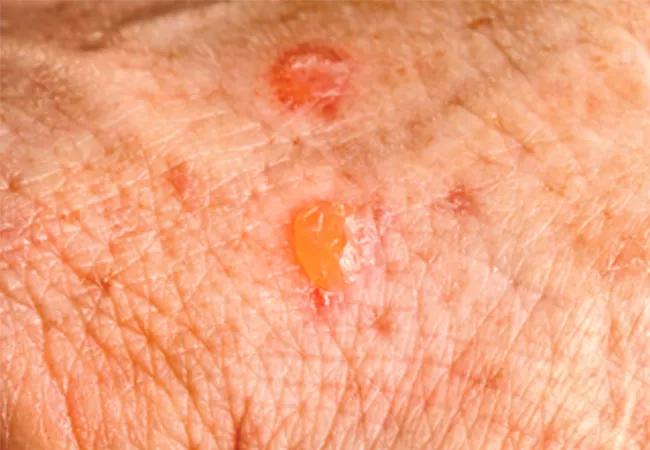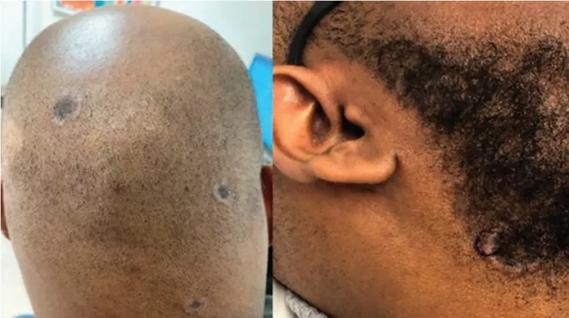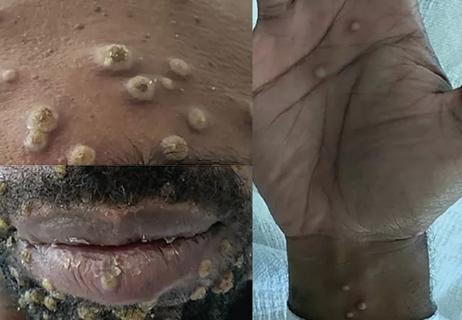Results are even better when used together

Patients with a history of long-term sun exposure often develop actinic keratoses (AK), rough, scaly lesions that are precursors to squamous cell carcinoma. Dermatologists can use liquid nitrogen or surgery to remove lesions from patients with a small number of AK, but for patients with dozens to hundreds of these lesions on their face, scalp, arms, legs, chest or back, a therapy that can cover a broad area (a “field treatment”) is needed.
Cleveland Clinic is a non-profit academic medical center. Advertising on our site helps support our mission. We do not endorse non-Cleveland Clinic products or services. Policy
Two standard field treatments for AK are photodynamic therapy (PDT), which uses visible light, and 5-fluorouracil (5FU), a topical cream. Both kill cancer cells, but research has shown that their efficacy and side effects could be improved.
For instance, patients must apply 5FU daily for three to five weeks to induce a pronounced inflammatory state that most find difficult to tolerate. With PDT, the skin does not blister or scar, yet some cancer cells still manage to escape the treatment.
Patients who undergo PDT first receive a prodrug, 5-aminolevulinic acid (ALA), a natural precursor of protoporphyrin IX (PpIX). When ALA is given as a concentrated solution, the cancer cells absorb it into their mitochondria, it is converted into PpIX, and it grows from a small molecule into a large molecule. Subsequent illumination with visible light activates the PpIX, which initiates oxygen-dependent photochemistry, thus destroying mitochondrial membranes, activating apoptotic pathways and eventually leading to tumor cell death.
While both 5FU and PDT are effective as monotherapies, researchers recently conducted a clinical trial to determine if there was a way to combine them and achieve a better result.
“Here are two cancer treatments already being used, and we wondered if you could get a significant improvement in outcome if you used them together in the right way,” said Edward Maytin, MD, PhD, Section Head of Molecular Dermatology at Cleveland Clinic. Dr. Maytin was first author on the study published in Clinical Cancer Research.
The trial studied 17 patients over age 60 with a significant history of skin cancer, multiple prior sunburns and extensive outdoor exposure. Each patient served as his or her own control — half of the face or scalp received six days of 5FU treatment followed by ALA and PDT, while the other half received only ALA and PDT.
Researchers measured the amount of PpIX produced within AK lesions one hour before and three hours after the application of ALA on two different days within the treatment period.
They found that treatment with 5FU prior to PDT led to a 2.2-fold increase in PpIX accumulation in cancer cells’ mitochondria. They also found that 5FU pretreatment of AK lesions caused reproducible changes in the expression of two enzymes that are immediately upstream and downstream of PpIX: coproporphyrinogen oxidase (CPO) and ferrochelatase (FC). For CPO, expression is induced by 5FU, whereas for FC, expression is decreased. The net result is a higher accumulation of PpIX.
At three and six months after treatment, researchers compared the number of lesions on each side of patients’ faces or scalps and found the difference to be statistically significant.
“We got 80 percent clearance of the cancer cells when we used both treatments together,” says Dr. Maytin, “and only about 40 percent when we used just photodynamic therapy.”
In addition to his clinical research, since 2000 Dr. Maytin has been using animal models to find a way to make PDT more effective. He realized that if researchers could induce cancer cells to make more PpIX, the cells would become even better targets.
“We tried many ways to do that,” he says. “We found that 5FU — if you use just a little bit of it for a short time — can make the cancer cells produce a whole lot more protoporphyrin.”
Dr. Maytin now is running an NIH-sponsored clinical trial to see if vitamin D might have a similar effect. This trial includes patients who are vitamin D-deficient and patients who have normal or high levels of vitamin D. It will study whether vitamin D-deficient patients respond as well to PDT.
The grant also is funding a study on the response of patients with basal cell skin cancer who receive vitamin D supplements one week prior to receiving PDT.
Meanwhile, Dr. Maytin is excited about the results of 5FU/PDT combined therapy.
“Any dermatologist could read this paper and start offering this treatment to his or her patients,” he says. “We don’t have to wait for Phase 3 studies and FDA clearance; it’s ready to go.”

Consider secondary syphilis in the differential of annular lesions

Persistent rectal pain leads to diffuse pustules

Techniques are borrowed from rhinoplasty, malar augmentation and others

Two cases — both tremendously different in their level of complexity — illustrate the core principles of nasal reconstruction

Stress and immunosuppression can trigger reactivation of latent virus

Low-dose, monitored prescription therapy demonstrates success

Antioxidants, barrier-enhancing agents can improve thinning hair